The Economics and Statistics Division maintains archives of previous publications for accountability purposes, but makes no updates to keep these documents current with the latest data revisions from Statistics Canada. As a result, information in older documents may not be accurate. Please exercise caution when referring to older documents. For the latest information and historical data, please contact the individual listed to the right.
<--- Return to Archive
For additional information relating to this article, please contact:
April 20, 2018ANALYSIS OF NOVA SCOTIA'S CONSUMER PRICE INDEX FOR MARCH 2018 In Nova Scotia March 2018, year over year growth for the All-Items Consumer Price Index was 2.4 per cent, above the national average of 2.3 per cent. Monthly consumer prices were up 0.4 per cent in Nova Scotia and up 0.3 per cent in Canada.
Within Atlantic Canada, New Brunswick (+2.5 per cent) had higher inflation than Nova Scotia. PEI was level with Nova Scotia at 2.4 per cent and Newfoundland and Labrador saw a 1.6 per cent year over year increase in prices.
All other provinces experienced positive year over year inflation in March.

Nova Scotia's annual consumer price inflation (year over year growth in CPI) excluding food and energy rose 2.2 per cent in March, above the national rate of 1.9 per cent. Price level gains for this index were largest in Saskatchewan and BC (both +2.4 per cent), and lowest in Quebec (+1.1 per cent). On a monthly basis, Nova Scotia's index excluding food and energy was up 0.8 per cent.
The main contributors to the monthly (March 2018 vs. February 2018) NS CPI movement:
Recreational equipment and services (excluding recreational vehicles) (+10.9%)
Footwear (+6.2%)
Fresh fruit (-6.1%)
Preserved vegetables and vegetable preparations (-6.5%)
The main contributors to the annual (March 2018 vs. March 2017) NS CPI movement:
Inter-City transportation (+15.4%)
Fuel oil and other fuels (+10.8%)
Furniture (-5.5%)
Fresh or frozen chicken (-8.0%)
The CPI for food in Nova Scotia increased 0.6 per cent year-over-year with a 0.9 per cent decrease month-over-month. CPI growth in food (year over year) was up in all provinces. Nationally, annual food prices increased 1.7 per cent.
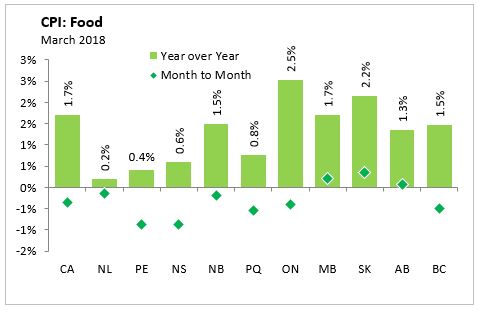
The Nova Scotia energy index increased by 7.2 per cent compared to a year ago. Energy price growth was smallest in Newfoundland and Labrador on a year over year basis (+2.9%) and largest in Alberta (+16.0%). Nationally, the index was up 7.5 per cent.
Major Components for March 2018
The following table shows the price increases specific to Nova Scotia for the major components of the CPI this month:
Long Run Trends
The All-Items CPI year over year inflation rate for Nova Scotia was above Canada's in March 2018. Nova Scotia's annual inflation has remained below the Canadian average since mid-2014, with the exception of only a few months. It has, however, been above the Canadian average in February and March of this year. While month to month movements in the indices can be different, over time they generally follow the same overall trend.
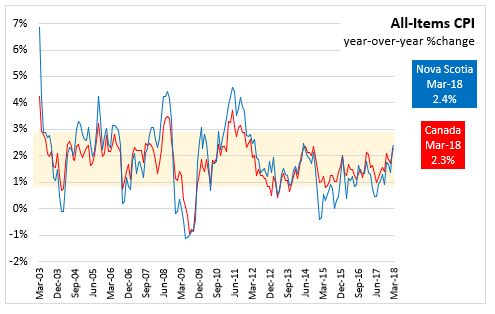
Annual inflation for the CPI excluding food and energy was higher for Nova Scotia (+2.2 per cent) than for Canada (+1.9 per cent).
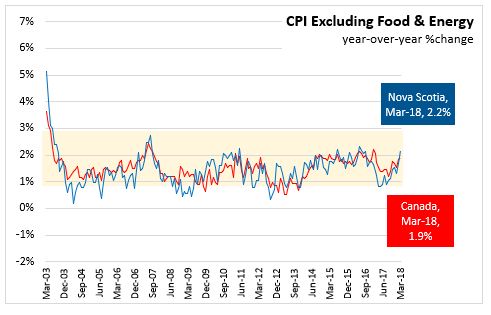
Bank of Canada's preferred measures of core inflation
Compared with March 2017, CPI-Common rose 1.9 per cent, CPI-Median rose 2.1 per cent, and CPI-Trim rose 2.0 per cent in Canada. All-items CPI excluding eight of the most volatile components as defined by the Bank of Canada and excluding the effect of changes in indirect taxes (formerly referred to as CPIX) rose 1.4 per cent year over year in March 2018.
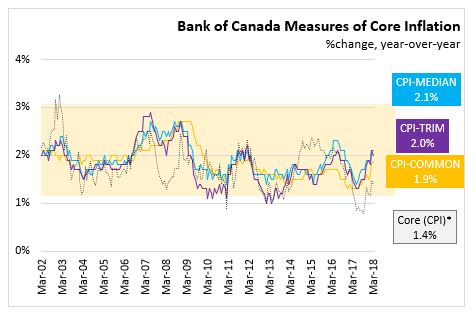
Appendix Tables and Charts

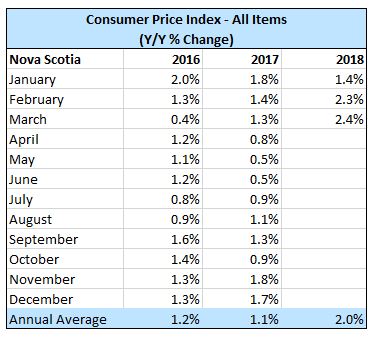
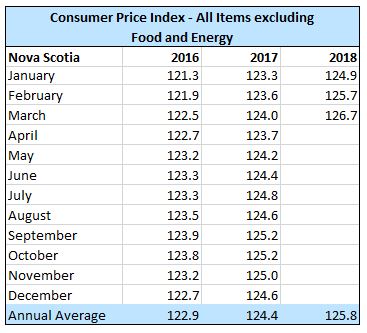
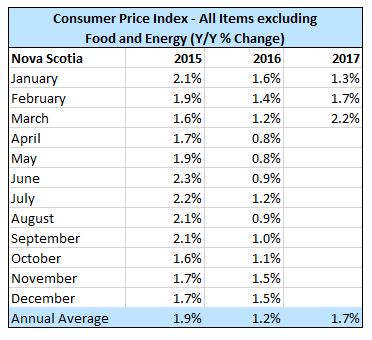
Source: Statistics Canada CANSIM Tables 326-0020 , 326-0023
<--- Return to Archive